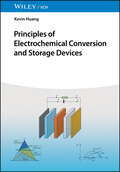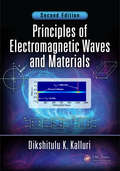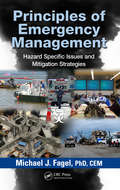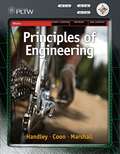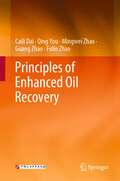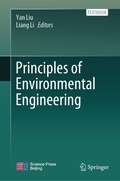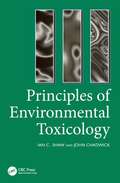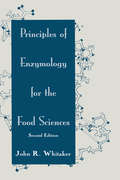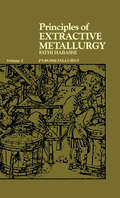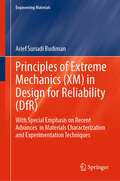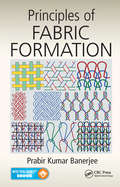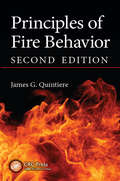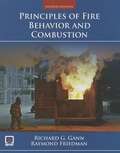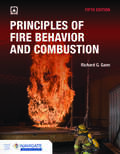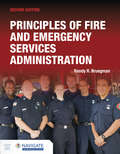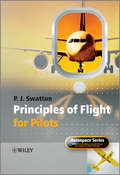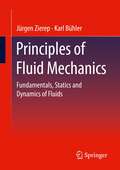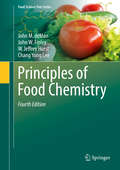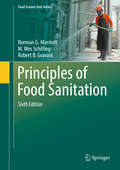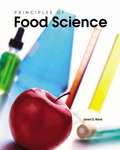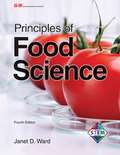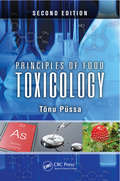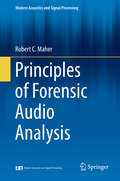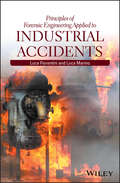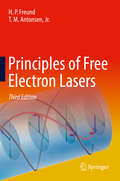- Table View
- List View
Principles of Electrochemical Conversion and Storage Devices
by Kevin HuangComprehensive resource covering fundamental principles of electrochemical energy conversion and storage technologies including fuel cells, batteries, and capacitors Starting with the importance and background of electrochemical foundations, Principles of Electrochemical Conversion and Storage Devices explains the working principles and electrochemistry of electrochemical cells. After a summary of thermodynamic and kinetics, different types of fuel cells as well as batteries and capacitors are covered. This book is written in the style of a textbook, providing illustrative examples and inspiring problems to facilitate the understanding of essential principles of electrochemical cells while offering practical insights for research pursuits. Various application examples are provided at the end of each chapter to strengthen reader understanding of energy storage from a practical point of view. Written by a highly qualified and awarded academic and based on a culmination of his two decades of personal teaching and research experience in the field, Principles of Electrochemical Conversion and Storage Devices includes information on: Common reference electrodes and potentials, standard electrode potentials in aqueous solutions, and current functions for the charge transfer processStandard Gibbs free energy of formation of selected compounds, standard heat of combustion of common fuels, and commonly used physical constantsLatest developments in the field, especially surrounding clean energy technologies, and various experimental methods essential for conducting rigorous electrochemical researchCharacterizing methods, key materials, and governing principles behind all of the covered devices Providing comprehensive coverage of the subject, Principles of Electrochemical Conversion and Storage Devices is an excellent resource tailored for researchers and students from all technical and natural science disciplines seeking to understand more about the most promising energy-related devices and the potential they hold to change the world.
Principles of Electromagnetic Waves and Materials
by Dikshitulu K. KalluriThis book focuses primarily on senior undergraduates and graduates in Electromagnetics Waves and Materials courses. The book takes an integrative approach to the subject of electromagnetics by supplementing quintessential "old school" information and methods with instruction in the use of new commercial software such as MATLAB. Homework problems, PowerPoint slides, an instructor’s manual, a solutions manual, MATLAB downloads, quizzes, and suggested examination problems are included. Revised throughout, this new edition includes two key new chapters on artificial electromagnetic materials and electromagnetics of moving media.
Principles of Emergency Management: Hazard Specific Issues and Mitigation Strategies
by Michael J. FagelPrinciples of Emergency Management: Hazard Specific Issues and Mitigation offers preparedness and mitigation recommendations for advanced emergency planning. Because disasters are so unpredictable, advance planning is needed to effectively respond to and mitigate against the potential effects of such events.Whether a disaster is natural or man-made
Principles of Engineering
by Brett A. Handley David M. Marshall Craig CoonPRINCIPLES OF ENGINEERING will help readers better understand the engineering concepts, mathematics, and scientific principles that form the foundation of the Project Lead the Way (PLTW) Principles Of Engineering course. Important concepts and processes are explained throughout using full-color photographs and illustrations. Appropriate for high school students, the mathematics covered includes algebra and trigonometry. Strong pedagogical features to aid comprehension include: Case Studies, boxed articles such as Fun Facts and Points of Interest, Your Turn activities, suggestions for Off-Road Exploration, connections to STEM concepts, Career Profiles, Design Briefs, and example pages from Engineers' Notebooks. Each chapter concludes with questions designed to test the reader's knowledge of information presented in the chapter, along with a hands-on challenge or exercise that compliments the content and lends itself to exploration. Key vocabulary terms are highlighted throughout the book and emphasized in margin definitions.
Principles of Enhanced Oil Recovery
by Caili Dai Fulin Zhao Qing You Mingwei Zhao Guang ZhaoThis book presents the latest progress in enhanced oil recovery technology and introduces the application of various enhanced oil recovery methods in oilfield development. Enhanced oil recovery (EOR) is a continuous theme in oilfield development. Due to the influence of geological conditions, development mode and physical and chemical factors, more than half of the proven oil reserves remain underground and cannot be accessed. Therefore, many enhanced oil recovery methods have been developed to achieve higher oil recovery. This book presents the basic principles and provides the chemistry knowledge related to enhanced oil recovery. It also expounds the applicable criteria of chemical agents. In addition, combined with field application examples, the limitations of existing enhanced oil recovery methods are analyzed, and the future development direction of enhanced oil recovery technology is highlighted. It is worth noting that the integral profile control and water shutoff technology in this book is widely recognized in the enhanced oil recovery industry and has achieved remarkable economic benefits. Given its scope, this book is useful for the scientific and technical personnel engaged in the study of oil recovery chemistry and enhanced oil recovery and also as a teaching reference for teachers and students majoring in petroleum engineering and oilfield chemistry.
Principles of Environmental Engineering
by Yan Liu Liang LiThis textbook contains the contents coming from hydraulics, hydrodynamics, chemical principles, chemical reaction engineering and bioengineering, which relates closely with fundamental principles in environmental engineering. It mainly covers principles including basic concepts, theories, methods and related equipment in fluid flow and transportation, heat transfer, absorption, chemical and biological reaction kinetics and reactors, as well as their applications in environmental engineering. At same time, the readers learns the basic viewpoints and methods commonly used in engineering technology, such as balance method, reasonable simplification, dimensional analysis method, boundary layer theory, optimization and mathematical model method. It broadens the student’s understanding in solving those problems in environmental engineering, and enhances their awareness of industrialization. This book is the specialized foundation and principles for learning the professional courses of environmental engineering, such as "water pollution control," "air pollution control," "solid waste treatment and disposal" and "ecological restoration engineering", while avoiding the repetition of the contents of those professional books.
Principles of Environmental Toxicology
by J. Chadwick I. ShawEnvironmental toxicology is the study of the action of chemicals upon ecosystems. Understanding the effects of exogenous chemicals upon the inhabitants of an ecosystem may enable us to predict and possibly prevent their deleterious effects. This textbook provides a good general introduction to all the major areas of environmental toxicology, including the fate of chemicals in the environment, environmental toxicity testing, risk assessment, radioactivity in the environment, legislation, environmental monitoring and the future impact of industrial development on the environment. It is written in an informal, accessible style with many examples of environmental issues taken from the author's personal experience and will provide students and other interested individuals with a broad overview of the science of environmental toxicology.
Principles of Enzymology for the Food Sciences (Food Science And Technology Ser. #61)
by John R. WhitakerThis second edition explains the fundamentals of enzymology and describes the role of enzymes in food, agricultural and health sciences. Among other topics, it provides new methods for protein determination and purification; examines the novel concept of hysteresis; and furnishes new information on proteases, oxidases, polyphenol oxidases, lipoxygenases and the enzymology of biotechnology.
Principles of Extractive Metallurgy: An Introduction To Extractive Metallurgy (Morgan Kaufmann Series In Data Management Systems)
by F. Habashi"First Published in 2017. Routledge is an imprint of Taylor & Francis, an Informa company."
Principles of Extreme Mechanics: With Special Emphasis on Recent Advances in Materials Characterization and Experimentation Techniques (Engineering Materials)
by Arief Suriadi BudimanThis book addresses issues pertinent to mechanics and stress generation, especially in recent advanced cases of technology developments, spanning from micrometer interconnects in solar photovoltaics (PV), next-gen energy storage devices to multilayers of nano-scale composites enabling novel stretchable/flexible conductor technologies. In these cases, the mechanics of materials have been pushed to the extreme edges of human knowledge to enable cutting-edge, unprecedented functionalities and technological innovations. Synchrotron X-ray diffraction, in situ small-scale mechanical testing combined with physics-based computational modeling/simulation, has been widely used approaches to probe these mechanics of the materials at their extreme limits due to their recently discovered distinct advantages. The techniques discussed in this manuscript are highlights specially curated from the broad body of work recently reported in the literature, especially ones that the author had led the pursuits at the frontier himself. Extreme stress generation in these advanced material leads to often new failure modes, and hence, the reliability of the final product is directly affected. From the recent topics and various advanced case studies covered in this book, the reader gets an updated knowledge of how new mechanics can and has been applied in Design-for-Reliability (DfR) for some of the latest technological innovations known in our modern world. Further, this also helps in building better designs, which may avoid the pitfalls of the current practiced trends.
Principles of Fabric Formation
by Prabir Kumar BanerjeeTextile fabrics of various structures are being increasingly used by engineers of different disciplines. This junior/senior undergraduate-level textbook focuses on the diverse technical principles involved at each stage of the formation of different types of fabrics. The book covers topics such as winding, warping, sizing, woven fabric construction, weaving, weft knitting, warp knitting, braiding, nonwovens, triaxial, multiaxial, and 3-D fabrics. A solutions manual is also available upon qualifying course adoption.
Principles of Fire Behavior (Career Education Ser.)
by James G. QuintiereThis text covers the four forms of fire: diffusion flames, smoldering, spontaneous combustion, and premixed flames. Using a quantitative approach, the text introduces the scientific principles of fire behavior, with coverage of heat transfer, ignition, flame spread, fire plumes, and heat flux as a damage variable. Cases, examples, problems, selected color illustrations and review of mathematics help students in fire safety and investigation understand fire from a scientific point of view.
Principles of Fire Behavior and Combustion (Fourth Edition)
by Richard G. Gann Raymond FriedmanThis expanded edition addresses all the course objectives and learning outcomes for the National Fire Academy FESHE Model Curriculum Associate's (Core) course called Fire Behavior and Combustion.
Principles of Fire Behavior and Combustion with Advantage Access
by Richard GannPrinciples of Fire Behavior and Combustion, Fifth Edition with Navigate Advantage Access is the most current and accurate source of fire behavior information available to firefighters and fire science students today. Readers will develop a thorough understanding of the chemical and physical properties of flammable materials and fire, the combustion process, and the latest in suppression and extinguishment.
Principles of Fire and Emergency Services Administration includes Navigate Advantage Access
by Randy R BruegmanThe Principles of Fire and Emergency Services Administration, Second Edition provides in-depth information needed to be a successful company officer, battalion, commander, deputy chief or chief executive officer, providing the necessary base curriculum to meet the FESHE requirements.
Principles of Flight for Pilots
by Peter J. SwattonOrganised and written as an accessible study guide for student pilots wishing to take commercial ground examinations to obtain ATPL or CPL licenses, Principles of Flight for Pilots also provides a reliable up-to-date reference for qualified and experienced personnel wishing to further improve their understanding of the Principles of Flight and related subjects. Providing a unique aerodynamics reference tool, unlike any book previously Principles of Flight for Pilots explains in significant depth all the topics necessary to pass the Principles of Flight examination as required by the EASA syllabus.Aviation ground instructor Peter J. Swatton, well reputed for his previous works in the field of pilot ground training, presents the subject in seven parts including basic aerodynamics; level flight aerodynamics; stability; manoeuvre aerodynamics; and other aerodynamic considerations. Each chapter includes self-assessed questions, 848 in total spread over eighteen chapters, with solutions provided at the end of the book containing full calculations and explanations.
Principles of Fluid Mechanics: Fundamentals, Statics and Dynamics of Fluids
by Jürgen Zierep Karl BühlerThis mature textbook brings the fundamentals of fluid mechanics in a concise and mathematically understandable presentation. In the current edition, a section on dissipation and viscous potential flows has been added. Exercises with solutions help to apply the material correctly and promote understanding. This book is a translation of the original German 11th edition Grundzüge der Strömungslehre by Jürgen Zierep & Karl Bühler, published by Springer Fachmedien Wiesbaden GmbH, part of Springer Nature in 2018. The translation was done with the help of artificial intelligence (machine translation by the service DeepL.com). A subsequent human revision was done primarily in terms of content, so that the book will read stylistically differently from a conventional translation. Springer Nature works continuously to further the development of tools for the production of books and on the related technologies to support the authors.
Principles of Food Chemistry (Food Science Text Series)
by John M. DeMan John W. Finley W. Jeffrey Hurst Chang Yong LeeCompletely revised, this new edition updates the chemical and physical properties of major food components including water, carbohydrates, proteins, lipids, minerals vitamins and enzymes. Chapters on color, flavor and texture help the student understand key factors in the visual and organoleptic aspects of food. The chapter on contaminants and additives provides an updated view of their importance in food safety. Revised chapters on beer and wine production, and herbs and spices, provide the student with an understanding of the chemistry associated with these two areas which are growing rapidly in consumer interest. New to this edition is a chapter on the basics of GMOs. Each chapter contains new tables and illustrations, and an extensive bibliography, providing readers with ready access to relevant literature and links to the internet where appropriate. Just like its widely used predecessors, this new edition is valuable as a textbook and reference.
Principles of Food Sanitation (Food Science Text Ser.)
by Robert B. Gravani Norman G. Marriott M. Wes SchillingNow in its 6th Edition, this highly acclaimed textbook provides sanitation information needed to ensure hygienic practices and safe food for food industry personnel as well as students. It addresses the principles related to contamination, cleaning compounds, sanitizers, cleaning equipment. It also presents specific directions for applying these concepts to attain hygienic conditions in food processing or food preparation operations.New in this edition: Updated chapters on the fundamentals of food sanitation, contamination sources and hygiene, Hazard Analysis Critical Control Points, cleaning and sanitizing equipment, waste handling disposal, biosecurity, allergens, quality assurance, pest control, cleaning compound and sanitizer properties and selection criteria, hygienic construction, sanitation guidelines for food and foodservice establishments, and sanitation management principles.
Principles of Food Science
by Janet D. Ward Larry T. WardPrinciples of Food Science is designed to help you learn about the relationships among science, food, and nutrition. Basic laws of chemistry, microbiology, and physics are applied to the production, processing, preservation, and packaging of food. You will explore the characteristics of each component found in food. You will examine the helpful and harmful effects of micro-organisms on the food supply.
Principles of Food Toxicology
by Tõnu PüssaFollowing in the tradition of the popular first edition, Principles of Food Toxicology, Second Edition integrates the general principles of toxicology with a systematic characterization of the most important food-borne toxicants. Ideal as a textbook in a food toxicology course, and also as a monograph dealing with principles of food toxicology as t
Principles of Forensic Audio Analysis (Modern Acoustics and Signal Processing)
by Robert C. MaherThis book provides an expert introduction to audio forensics, an essential specialty in modern forensic science, equipping readers with the fundamental background necessary to understand and participate in this exciting and important field of study. Modern audio forensic analysis combines skills in digital signal processing, the physics of sound propagation, acoustical phonetics, audio engineering, and many other fields. Scientists and engineers who work in the field of audio forensics are called upon to address issues of authenticity, quality enhancement, and signal interpretation for audio evidence that is important to a criminal law enforcement investigation, an accident investigation board, or an official civil inquiry.Expertise in audio forensics has never been more important. In addition to routine recordings from emergency call centers and police radio dispatchers, inexpensive portable audio/video recording systems are now in widespread use. Forensic evidence from the scene of a civil or criminal incident increasingly involves dashboard recorders in police cars, vest-pocket personal recorders worn by law enforcement officers, smart phone recordings from bystanders, and security surveillance systems in public areas and businesses. Utilizing new research findings and both historical and contemporary casework examples, this book blends audio forensic theory and practice in an informative and readable manner suitable for any scientifically-literate reader. Extensive examples, supplementary material, and authoritative references are also included for those who are interested in delving deeper into the field.
Principles of Forensic Engineering Applied to Industrial Accidents
by Luca Fiorentini Luca MarmoAn introductory text on the investigation of industrial accidents Forensic engineering should be seen as a rigorous approach to the discovery of root causes that lead to an accident or near-miss. The approach should be suitable to identify both the immediate causes as well as the underlying factors that affected, amplified, or modified the events in terms of consequences, evolution, dynamics, etc., as well as the contribution of an eventual "human error". This book is a concise and introductory volume to the forensic engineering discipline which helps the reader to recognize the link among those important, very specialized aspects of the same problem in the global strategy of learning from accidents (or near-misses). The reader will benefit from a single point of access to this very large, technical literature that can be only correctly understood with the right terms, definitions, and links in mind. Keywords: Presents simple (real) cases, as well as giving an overview of more complex ones, each of them investigated within the same framework; Gives the readers the bibliography to access more in-depth specific aspects; Offers an overview of the most commonly used methodologies and techniques to investigate accidents, including the evidence that should be collected to define the cause, dynamics and responsibilities of an industrial accident, as well as the most appropriate methods to collect and preserve the evidence through an appropriate chain of security. Principles of Forensic Engineering Applied to Industrial Accidents is essential reading for researchers and practitioners in forensic engineering, as well as graduate students in forensic engineering departments and other professionals.
Principles of Free Electron Lasers
by H. P. Freund T. M. Antonsen Jr.This book presents a comprehensive description of the physics of free-electron lasers starting from the fundamentals and proceeding through detailed derivations of the equations describing electron trajectories, and spontaneous and stimulated emission. Linear and nonlinear analyses are described, as are detailed explanations of the nonlinear simulation of a variety of configurations including amplifiers, oscillators, self-amplified spontaneous emission, high-gain harmonic generation, and optical klystrons. Theory and simulation are anchored using comprehensive comparisons with a wide variety of experiments.
